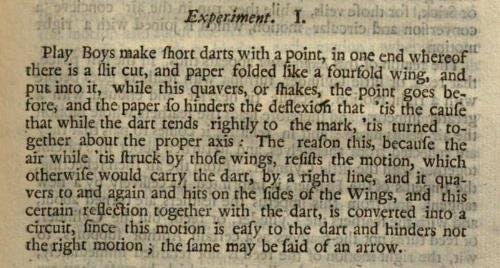Paper Flights (But Not Of Fancy)
The long (and sometimes dangerous) history of folded paper fletchings
The book 'Les Jeux et Plaisirs de l'Enfance' which was published in 1657, contains 50 engravings of (mostly) naked boys engaged in playing various, often very robust, games. If you are interested, you can look through all the various engravings here. They provide an excellent overview of the activities enjoyed by boys at this time. I am not quite sure why the boys are naked. It is possibly a classical reference (in Ancient Greece men used to exercise in the nude), but I am pleased to see that the boys are at least clothed while playing on the ice.
Not unnaturally, the engraving that caught my interest the most was this one of the boys playing darts. The darts seem to be wooden dowels with metal pins or needles set in one end, and flights, which look as though they could well be made of paper, possibly from a square folded into a waterbomb base, set in the other. Could this possibly be true? In 1657? At such an early date? I was a little wary to accept the evidence of my eyes at first, because the angles of the flights shown in the engraving are not quite the angles you would expect if they were waterbomb bases (though this, of course, could be down to artistic licence in the engraving).
Then I discovered that a new version of the book, edited by Alexandre Chaponnier, which containing just twelve of the original engravings, had been published in 1800. One of the twelve was 'Les Dards', the image of the boys playing darts. I was delighted to find that Chaponnier had helpfully added an explanatory note.
According to this text, the flights were 'un papier plie en quatre et introduit dans deux fentes en croix' (a paper folded in four and inserted in two cross slits) which confirms the idea that they were formed by folding a waterbomb base from a square.
More recently I found a passage in the book 'Mechanick Powers: Or, The Mistery of Nature and Art Unvail'd' by Ven. Mandey and J Moxon, which was published in London in 1696, which also references paper flights of this kind.
It does seem to me, from a modern perspective, that this game of ‘Dart and Target’, as the Victorians called it, is not without its dangers, since. in my experience at least, it is not unknown for a carelessly thrown dart to go astray. I once, for instance, had one penetrate my shoe and pierce my foot. Not a life-changing injury, but painful at the time.
This is apparently not a new phenomenon. An obituary for William Kitchiner, which appeared in the July 1794 edition of The Gentleman's magazine, includes a paragraph concerning his son who lost an eye to a 'paper arrow, armed with a pin'.
Despite the obvious dangers, darts equipped with paper flights did not go out of fashion quickly, although the design did change. Waterbomb bases went out and preliminary folds came in. Perhaps preliminary folds are more aerodynamic.
This change may have occurred around the time that some enterprising gentleman, clearly unaware of, or deliberately ignoring, the long previous history of the paper flight, applied for a patent that stated: ‘My invention relates to … a dart … whereof the feather is of four-wing construction and is formed from a foldable blank of paper or other flexible material …’. The patent was approved on 1 November 1898. ‘My invention’? Hmmmm …
Even in the 1950s, I am told, before the widespread advent of plastic, darts players frequently made their own paper flights out of paper in this way. (In 'Paper Magic' by Robert Harbin, which was published by Oldbourne in London in 1956, his 'Basic Fold Three', which we now know as the preliminary fold, is called 'The Dart Flight'.)
This photo culled from the internet, unfortunately undated, shows a set of darts with paper flights made from preliminary folds. The wooden dowels have been replaced with brass barrels, but, presumably, they are no less dangerous for that. Anyone for a game?








Great stuff! I still don't know how you find all these things, especially the images. I've been looking again and found the Dart and Paper Dart in "Cassell's Book of Indoor Amusements" (1881) and its source book "The Popular Recreator" (1873). Maybe the "inventor" of patent US613386 (granted not long after in 1898) found it in there, because it seems very closely related. Also it's interesting that the patent describes both the Preliminary Base and Waterbomb Base versions of the dart flight (the latter being preferred because it offers less air resistance).